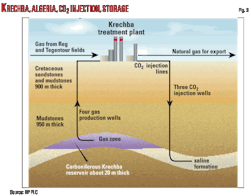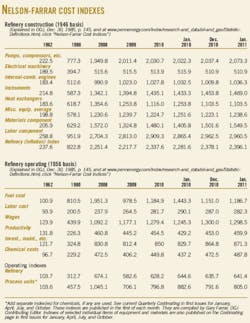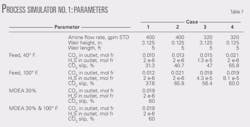Seven shale plays dominate today's North America natural gas potential reserves additions and production increases.
Contrary to prior expectations of gas strategists and forecasts of gloom,1 today North America is awash in natural gas supply. While reduced demand (–1.6 bcfd) and the new Rockies Express pipeline (0.9 bcfd) have been partly responsible, gas shale development undoubtedly has been the single most important factor.
During the past 5 years, gas shale production grew to more than 8 bcfd from 2 bcfd (Fig. 1). For some time now, shale and other unconventional reservoirs have helped stabilize US gas production, offsetting long-term production declines from conventional sources. Then, in recent years, the shale growth accelerated markedly, helping to push up overall US gas production into growth territory for the first time in a decade (Fig. 2).
The gas shale transition began with the Barnett shale in North Texas, followed by the Fayetteville in Arkansas and the Woodford in Oklahoma, and then was accelerated by the gas shales in the Haynesville and the Marcellus in the US and the Horn River and Montney in Canada (Fig. 3). Expectations are that these seven shale plays (the "Magnificent Seven") will dominate future natural gas reserves additions and production increases.
Building on the lessons learned from US and Canadian gas shales, various companies are starting to pursue overseas gas shale exploration in prospective areas such as Europe, Australia, India, and other countries.
From a resource once relegated to small independent producers, today majors, large independents and national companies are pursuing the play. How did this transition come about and where is it headed?
This three-part series on gas shale development begins with a look at the established and emerging North American shale basins and plays. The next two parts will examine the evolving technological and environmental considerations for optimally producing shale reservoirs as well as the potential for developing emerging gas shale plays in North America and elsewhere.
Shallow, deep shales
The Section 29 nonconventional fuels tax credit in the 1980s helped develop and boost the economics of the marginally productive organic-rich gas shales such as Appalachia's Devonian Ohio shale and Michigan basin's Antrim shale.
Companies developed these shallow (500-2,500 ft deep) shale plays with conventional vertical wells and small hydraulic stimulations. Production was modest, generally about 100 Mcfd/well but long-lasting with reserves in the 0.25 bcf/well range. Fortunately, capital costs also were low.
These shallow, low-maturity, clay-rich shale reservoirs store gas mainly from methane adsorption, with only a small porosity gas component. Today, these shallow shales produce about 1 bcfd.
Modern deep shale development began about 1995 with emergence of the Barnett shale play in the Fort Worth basin, North Texas (Fig. 4). Long known for its gas-rich deposit, the Barnett at 8,000 ft pushed the depth envelope for favorable flow capacity.
Mitchell Energy & Development Corp.'s innovative large slick-water fracs outperformed earlier small gel fracs but their vertical wells still recovered just a small percent of the gas in place.2 The first US Geological Survey assessment placed technical recovery from the Barnett Shale at just 3.4 tcf.3
Devon Energy Corp. acquired Mitchell in 2000 and recognized it could create more reservoir flow paths with a cased 4,000-ft horizontal well stimulated with large slick-water fracs containing several million pounds of sand proppant and pumped in 8-12 stages. Recovery increased manyfold compared with earlier vertical wells. As horizontal drilling and fracturing technology advanced, Barnett core area wells have improved to an average 2.5 bcfe/well. Current production from the entire play is almost 5 bcfed from more than 12,000 vertical and horizontal wells.
The Barnett's core area sweet spot has favorable depth, thickness, thermal maturity, pressure gradient, and a hard underlying sandstone that acts as a hydraulic fracture stress barrier, focusing energy within the shale reservoir. With access to new well performance and geologic data, an updated USGS resource assessment placed technical gas recovery from the Barnett at 26 tcf.4
At yearend 2008, however, cumulative production was 5 tcf with an additional 20 tcf of booked proved reserves, thus ultimate gas recovery needs an upward revision.
Advanced Resources puts the remaining undeveloped recoverable resource from the Barnett at 15-40 tcf, depending on gas prices. This gas play still has room to run.
Barnett lessons learned
A series of factors spurred the explosive growth of high-quality shale plays beyond the Barnett, as documented by internal studies performed recently by Advanced Resources, to be discussed in the second article.
The factors include a greater geologic understanding, advances in drilling and completions, and access to land and infrastructure.
Although the Barnett shale was an acknowledged deep horizontal shale success, doubts lingered over whether it was merely a one-of-a-kind geologic setting, such as the still-unmatched San Juan fairway coalbed methane play in New Mexico. Not until 2006, following Southwestern Energy Co.'s Fayetteville and Newfield Enegy Co.'s Woodford shale production breakthroughs, were the doubters finally silenced and the new shale exploration and development paradigm confirmed.
As it turned out, shale plays do not have to be Barnett look-alikes; their geologic settings can be remarkably varied.
For instance, reservoir depth can range from 3,000 ft in the Fayetteville to more than 14,000 ft in the Haynesville.
The key geologic precursors for deep shales turned out to be different than for the shallow shale plays. Modest but adequate porosity (6-12%) is essential for gas storage. Unusual mineralogy, low in ductile clays and high in brittle quartz, feldspar, and carbonate components, helps promote frac effectiveness.
The shale needs adequate thermal maturity (Ro >1.0%) to avoid unfavorable relative permeability from liquid hydrocarbons in the reservoir. Higher thermal maturity also promotes shrinkage of the total organic carbon (TOC), leading to higher effective permeability and often a fully gas-charged system. The shale needs an adequate TOC (2-5%) for gas storage by adsorption.
An equally important factor, requiring 3D seismic, is the avoidance of geohazards, such as water-bearing karsts and faults.
Natural fracturing turned out to be somewhat less important than initially assumed. Even with permeabilities in the nanodarcy range, artificial stimulation could create the resevoir's flow capacity.
Horizontal drilling coupled with large slick-water hydraulic fracturing, employing ever-increasing lateral length and proppant loads, often guided by real-time seismic monitoring, provides much more effective (5-10 times) flow capacity than traditional vertical wells.
Today, deep shale drillers all employ essentially the same Barnett-style well drilling and completion design: ±4,000-ft long laterals stimulated by multimillion-lb slick-water fracs in a dozen stages. Armed with these new techniques, deep shale development is spreading rapidly to the Marcellus, Haynesville, and Horn River shales. Advancements continue, including simultaneous fracturing of closely spaced wells (600-800 ft apart) to contain the injected energy and more intensively shatter the shale reservoir.5
Access, infrastructure
Companies generally can develop shale plays located in the US Midcontinent and East, where most land is owned privately, with minimal political wrangling. The fact that shale developments can cover entire counties means that royalties are spread among thousands of individual landowners, often aligning them with operators.
On the other hand, development of eastern gas shales has raised concerns among environmental organizations and the general public, slowing or stopping development.
At both the state and federal levels, pressure exists for more active regulatory oversight of shale gas development. Particular areas of concern are frac water sourcing and disposal, along with the perceived effect of fracturing operations on ground water.
The third article in this series on gas shales will further explore the critical geologic, well completion, and environmental issues important for more optimally developing these unconventional gas resources.
New shale operators.
A new breed of shale operators—mostly mid to large-cap independents—emboldened by the improved geologic understanding and production technologies, has leased millions of shale-prospective acres. Most have tacked adeptly through the recent economic turbulence, bolstered by price hedging and supportive capital markets.
Hedging and financial inflows have enabled operators to hold and develop their best shale acreage in spite of (and indeed exacerbating) the collapse of spot gas prices.
In another industry step change, during the past year majors such as BG Group, BP PLC, ExxonMobil Corp., Shell Canada Ltd., and StatoilHydro have entered shale plays in a significant way through leasing and acquisition.
These include BP's purchase of Chesapeake's Woodford shale properties for $1.75 billion, as well as the company's $1.9 billion deal for 25% of Chesapeake's Fayetteville shale position.
Shell acquired Duvernay Oil Corp. for $5.9 billion, including extensive Montney shale leases in Canada.
Statoil farmed into Chesapeake's Marcellus shale position for $3.3 billion.
BG Group acquired an interest in Exco Resources Inc.'s Haynesville shale acreage for $1.55 billion.
Others have taken the leasing approach in the Marcellus (Marathon Oil Co.), Eagleford (ConocoPhillips), and Horn River plays (ExxonMobil).
The Magnificent Seven
Including the Barnett, seven high-quality new deep gas shale plays are under development in North America: five in the US and two in Canada.
The high-quality core areas of these plays can have low overall full-cycle "break-even" costs of $4-5/Mcf, while the less favorable outer areas tend to have much higher costs. Advances in well drilling and completion technology would help lower the costs of developing the outer areas of these gas shale plays.
Fayetteville (Arkansas)
The eastern Arkoma basin's Fayetteville shale is a Mississippian Barnett-equivalent that extends across central Arkansas. It was the second deep shale to be commercialized. This discovery helped convince industry that the Barnett was not unique and that shale plays need not be geologic Barnett clones. This widened and intensified the global deep shale hunt.
The Fayetteville is shallower than the Barnett (3,000-5,000 ft deep vs. the Barnett's 6,000-8,000 ft) as well as thermally more mature (2.5% Ro vs. the Barnett's 1-1.5%). Carbonate collapse zones (karsts), which plague portions of the Barnett, are not present but water-bearing faults can occur.
The lower Fayetteville is the main completion target, as it is the most quartz-rich, high in total organic content, fairly porous, and gas-saturated zone.
Four shale-experienced operators dominate the Fayetteville shale play and production has increased rapidly to 1.3 bcfed today.
Southwestern Energy Co., with nearly a million net acres including much of the play's core area, recently attained the 1-bcfed benchmark. Others include Chesapeake-BP, XTO Energy Inc., and Petrohawk Enegy Corp.
Southwestern envisioned the play in 2002, drilled its first two vertical wells in 2003 to confirm reservoir quality, and eventually tested 33 pilots across its acreage to evaluate geologic quality and optimize well design.
Development started with vertical wells but soon switched to horizontals employing 2,500-ft laterals that were stimulated with crosslink gel fracs.
By 2007, Southwestern evolved its completion to longer laterals with slickwater fracs, both of which significantly improved gas production.
Recent wells are positioned using 3D seismic and typically employ 4,000+ ft laterals stimulated with a dozen or more frac stages.
Today, wells cost about $2.9 million (all-in), produce at initial rates of 3.0 MMcfd (30-day rate), and are expected to recover about 3.0 bcf/well in the core area. Active development continues despite low gas prices.
Woodford (Oklahoma)
The western Arkoma basin hosts the Mississippian-age Woodford shale play, which currently produces about 0.5 bcfed. Newfield Exploration Co. began to develop the play in 2006 and its early success helped bolster the global acceptance of deep shale as an exploration target.
The Woodford has some of the longest shale laterals drilled, up to 10,000 ft in the reservoir, thanks to enlightened state well-spacing regulations. Overall development, costs however, tend to be relatively high in the Woodford and low gas prices have severely curtailed drilling this year.
Production likely will plateau or even decline until gas prices recover. Newfield, the largest shale operator in the play, currently produces 240 MMcfed but has recently begun to release many of its rigs.
A geologically distinct emerging Woodford shale play occurs in the deep Anadarko basin. This "Cana" play has Haynesville-like 13,000-ft depths and is highly overpressured. Leading operators include Devon and Cimerex Energy Co. While the play is not yet proven, early well tests are encouraging.
Marcellus (Appalachia)
The Devonian Marcellus shale had been productive for decades in this region but in shallow settings. Then, starting about 5 years ago, success in the Barnett spurred operators to test the deeper portions of the Marcellus (5,000-9,000 ft depth) for the first time.
Recent geologic resource studies have helped quantify the potential of this huge shale target, which stretches from Kentucky to New York.
The USGS defined thickness, depth, and other reservoir parameters in 2002, conservatively estimating that the play had 1.9 tcf of recoverable resources.6 Academic and industry studies have since raised that estimate to as high as 500 tcf.
ARI's internal study of the play (using a database of more than 500 wells) puts recovery in the 100-200 tcf range, depending on gas prices, out of more than 1,600 tcf total gas-in-place resource.
Two Marcellus sweet spots have emerged. Southwestern Pennsylvania has fairly thick shale (100-150 ft) with high TOC. Marginally mature (Ro ~1%), this area produces wet gas that requires surface separation facilities.
Early-mover Range Resources Corp. has drilled 46 horizontal Marcellus wells, mostly in Washington County near Pittsburgh. Recent wells have an average 7 MMcfed initial potential, with one as high as 26 MMcfed (24-hr rates).
Range estimates recovery at about 4.4 bcfe/well, with a horizontal well estimated to cost $3.5 million (all-in).
The company estimates its total potentially recoverable resource from the Marcellus at 15-22 tcfe.
CNX Gas Corp. also reports good results in southwestern Pennsylvania, where it has drilled eight horizontal wells (6,000-ft vertical depth, 3,000-ft laterals) costing about $3.5 million, with initial potentials of up to 4.1 MMcfed.
Vertical wells also have been successful in the Marcellus. Atlas Energy Resources LLC has drilled more than 160 vertical Marcellus wells, with recent completions reported at 1.4 bcfe/well and costing just slightly more than $1 million/well. The company has increased its estimate of potentially recoverable resources on its acreage to about 9 tcfe.
Although companies likely will develop the Marcellus mainly with horizontal wells, verticals still will play a role.
A second sweet spot is developing in northeast Pennsylvania and south-central New York, where the Marcellus is exceptionally thick (200-400 ft). Cabot Oil & Gas Corp. has tested several wells here with initial potential's up to 9 MMcfed.
Ultra Oil & Gas Inc. has tested five horizontal wells, each coming in at more than 5.3 MMcfed (24-hr rates). Talisman Energy Inc., Chief Oil & Gas LLC, and Epsilon Energy Ltd. also report high-rate wells in this area. Other operators include Chesapeake, Southwestern, and Range.
Overall, Marcellus shale production currently is at about 200 MMcfed. Production is growing more slowly than in other shale plays because of rugged topography, a shortage of appropriate drilling rigs, environmental and regulatory hurdles, and the sheer size of the acreage, which must first be properly evaluated.
With its low finding and development costs, however, the vast Marcellus play may eventually reach or exceed Barnett Shale production rates.
Haynesville (Louisiana/Texas)
In late 2007, the "buzz" was that the massive Hayneville shale play in the Louisiana Salt basin of northern Louisiana and East Texas could eventually outshine even the Barnett shale.
The Haynesville shale is a Jurassic shale, much younger than the Mississippian Barnett, Fayetteville, and Woodford plays. It is also deeper (10,000-15,000+ ft), breaking the rules on where successful shale plays could go.
With decent levels of porosity (8-12%) in the eastern portion of the play area, the Haynesville is rich in brittle carbonates and quartz, particularly in its basal section.
The play's substantial depth, extreme overpressuring (up to 0.85 psi/ft), huge size (>1,000 tcf of gas in place), and rich resource concentration (>200 bcf/sq mile) place the Haynesville in rarefied company.7 But amazingly, there could be further upside: the overlying Bossier shale offers a secondary gas-charged completion target.
The primary challenge for the Haynesville is the high-pressure, high-temperature drilling environment and high resulting well costs of $10+ million. In addition, due to sharp initial year declines, long-term production and per-well reserves remain uncertain.
Companies still are defining the Haynesville's sweet spot. They have drilled excellent wells in portions of DeSoto, Caddo, Red River, and Bossier parishes, northern Louisiana, clustering around the 12-13,000 ft depth interval (Fig. 5). Core area wells frequently have an initial potential in excess of 20 MMcfed (24-hr rate).
Depending on decline rates these wells might be capable of producing 6-8 bcfe or more. Well costs are high but expected to drop with operational efficiencies such as pad drilling. Core area wells look attractive even at $4/MMbtu Henry Hub gas price.
The East Texas and extreme northern Louisiana portions of the Haynesville play are shallower (10-12,000 ft) and thicker (up to 400 ft). Reservoir quality, notably gas-filled porosity and brittle mineral content, however, appears lower. Wells typically have an initial potential below 10 MMcfed and will require higher gas prices to be economic.
Early thinking was that fracturing would require costly synthetic silicon carbide proppant for resisting the Haynesville's high pressures and temperatures. Most operators, however, have found low-cost resin-coated sand proppant to be adequate.
Haynesville shale operators include early-movers Chesapeake, EnCana Corp., Petrohawk, and Exco Resources, all with large core area positions.
Two dozen other operators are testing the horizons below their legacy gas fields, which produce from the Cotton Valley, and are acquiring undeveloped acreage.
Production, currently more than 1 bcfed, is growing much faster than in the Marcellus. Eventually production could approach Barnett production.
In a possible harbinger of deals to come, BG Group recently agreed to pay Exco $1.55 billion for a 50% share of certain upstream and midstream Haynesville assets in Louisiana. Numerous other operators are positioning to establish a stake in one of North America's largest and lowest-cost gas plays.
Horn River basin
A sequence of geologically attractive gas shales exist in the Horn River basin, in northeast British Columbia, with the Late Devonian Muskwa shale the most prominent. Often the Muskwa, Otter Park, and Horn River sequences are grouped within the broader Horn River terminology (Fig. 6).
The Horn River basin has an areal extent of about 5,000 sq miles. The Muskwa-Horn River shale within this basin is 300-500 ft thick in the heart of the play, thinning to 100-150 ft to the south near the Peace River arch.
Gas-filled porosity ranges 1-9%, with 3-4% typical.
Thermal maturity is high (Ro = 2-4%), reflecting a dry gas setting. There is potential for elevated CO2 in the more thermally mature areas.
At a representative 8,000 ft depth, the formation is overpressured with a 0.6 psi/ft reservoir pressure gradient.
The Muskwa shale is organically rich, with an average 3% organic carbon content.
Fig. 7 shows a side-by-side comparison of the Horn River basin Muskwa and Fort Worth basin Barnett shale wells. EOG Resources Inc. drilled both wells in geologically favorable settings.
The figure shows that the Muskwa shale is thicker and more mature, providing higher gas concentration. The Muskwa shale has a higher silica content of 65% vs. 55% for the Barnett shale, causing the Muskwa shale to be more brittle and favorable for hydraulic fracturing. The Muskwa and Barnett shale have similar permeabilities and gas-filled porosities.
Seven major companies, led by EnCana and Apache Corp., hold significant lease positions in the Horn River gas shale play.
Horizontal well drilling has had positive results, with initial rates of 3-10 MMcfd. Operators, however, are still testing and optimizing their drilling and well completion strategies.
Market outlets and high transportation costs are a concern, as is gaining year-round access to drilling sites. Two new regional pipelines are under development to bring gas to markets. A 24-in. line is due in service mid-2009 and a larger 36-in. line is due in service by mid-2011.
Other innovative market options include sending gas to the oil sands area in northern Alberta as well as to coastal Kitimat, BC, for export as LNG.
Montney shale
The Montney resource play represents a complex geological sequence that varies from conventional gas (and oil) along the eastern edge of the basin, to a combination tight gas and gas shale play in the center, and to a classical black massive gas shale complex along the western edge (Fig. 8).
The closest geological analog may be the complex Bossier sand and shale play on the Texas and Louisiana border.
The Montney resource covers a massive area, more than 35,000 sq miles, with geologic and reservoir properties changing dramatically from the eastern to the western portion of the play area.
The Mid to Lower Triassic-age deposit contains sandstones on the shallower (3,000 ft) eastern boundary of the play, grading to siltstone and shale in the deeper (8,000 ft) western boundary of the play.
In the western Montney play area, near Dawson Creek, the gas shale is thick, thermally mature with high organic content. In the northern portions of the area, north of Fort St. John, the Montney Shale has higher clay content and decreased silica, reducing the brittleness of the formation and its favorability for creating reservoir permeability and flow capacity with hydraulic stimulation.
While companies have drilled considerably in the eastern and central portions of the Montney resource play, they only have drilled lightly the western gas shale play. Early horizontal well performance in the geologically favorable portions of the area, however, has been attractive with initial 30-day gas rates of 5 MMcfd and relatively modest declines for gas shale wells.
A large number of operators hold leases in the heart of the Upper and Lower Montney gas resource play, led by EnCana (with about a million acres), Shell (after its purchase of Duvernay Oil in mid-2008), plus Talisman, Murphy Oil Corp., and ARC Energy Trust.
References
- Greenspan, A., Testimony Before the Committee on Energy and Commerce, US House of Representatives, June 10, 2003.
- Reeves, S.A., Kuuskraa, V.A., and Hill, D.G., "New basins invigorate US gas shales play," OGJ, Jan. 22, 1996, p. 53.
- Kuuskraa, V.A., Koperna, G., Schmoker, J.W., and Quinn, J.C., "Barnett shale rising star in Fort Worth basin," OGJ, May 25, 1998, p. 67.
- Pollastro, R.M., Hill, R.J., Jarvie, D.M., and Henry, M.E., "Assessing Undiscovered Resources of the Barnett-Paleozoic Total Petroleum System, Bend Arch—Fort Worth Basin Province, Texas," AAPG Southwest Section Meeting, Fort Worth, Mar. 1-4, 2003.
- Mutalik, P.N., and Gibson, B., "Case History of Sequential and Simultaneous Fracturing of the Barnett Shale in Parker County," Paper No. SPE 116124, SPE ATCE, Denver, Sept. 21-24, 2008.
- Assessment of Undiscovered Oil and Gas Resources of the Appalachian Basin Province, US Geological Survey, 2002.
- Parker, M., Buller, D., Petre, E., and Dreher, D., "Haynesville Shale–Petrophysical Evaluation," Paper No. SPE 1228937, SPE Rocky Mountain Petroleum Technology Conference, Apr. 14-16, 2009, Denver.
The authors
More Oil & Gas Journal Current Issue Articles
More Oil & Gas Journal Archives Issue Articles











